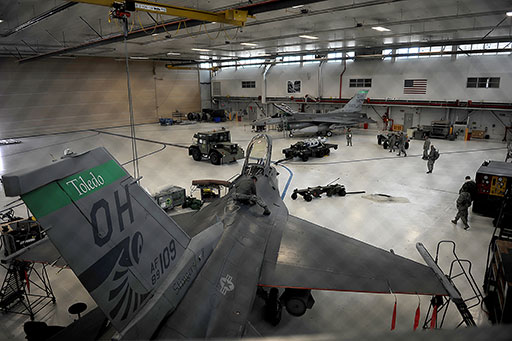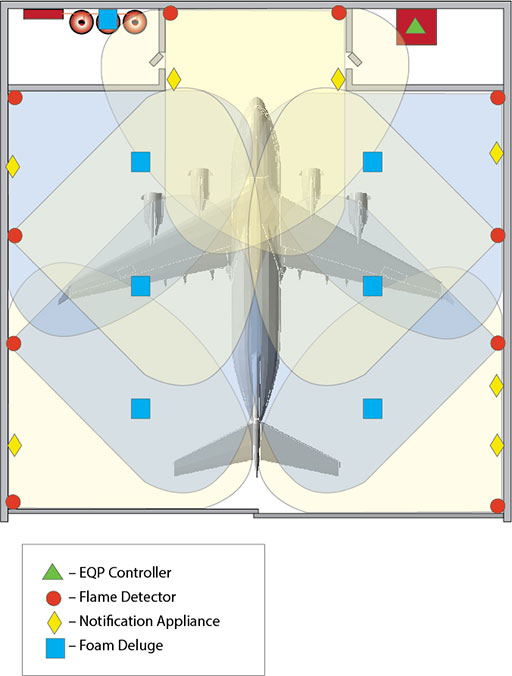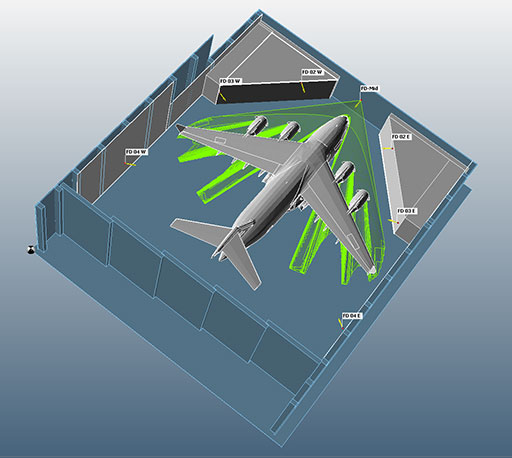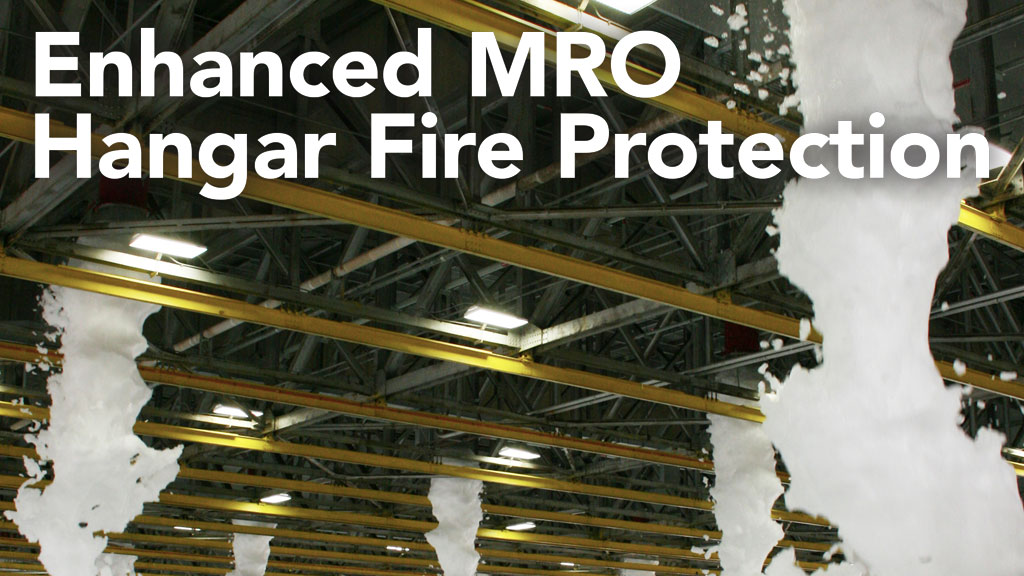It can actually take a relatively long time for a million dollar hangar to burn to the ground. It takes less than a minute for the multi-million dollar aircraft inside the hangar to become useless pieces of metal.

Fire detection and suppression in aircraft hangars has always been a major concern for the aircraft MRO industry. And as the value of the aircraft being worked on in those hangars has continually increased, the value of the hangars themselves has become secondary to the aircraft within them.

(Diagram courtesy of Det-Tronics.)
In the early days, fire detection depended on heat and smoke detectors to set off alarms and suppression systems, backed up by simple “pull down” stations dependent on human awareness. But as hangars get larger and more complex, smoke and heat can dissipate, significantly delaying the awareness of fire. Adding flame detectors can help eliminate those problems. Today, the use of flame detection to supplement heat and smoke detection is becoming a major element in successful hangar fire detection and suppression.
Standards for fire detection and suppression for aircraft hangars in the civil industry are coded under National Fire Protection Association (NFPA) 409, backed up by NFPA 410 dealing specifically with aircraft MRO facilities. The NFPA 409 refers to NFPA 72 for detector installation guidance, stating that the spectral response of the detectors must be matched to the spectral emission of the fire. Also, an evaluation to determine the location and spacing of the detectors must be based upon a number of considerations including the fuel involved, size of the fire and performance attributes of the flame detector.
The military established its fire protection standards for hangars under Unified Facilities Criteria (UFC) 4-211-01. Basically, the UFC includes NFPA 409, reinforced by additional standards dealing with fire barriers, fire resistance ratings and suppression. They are also aimed at greatly reducing false alarms that can trigger the release of fire suppression foam, leading to costly clean-up bills as well as damage to the aircraft. The military requires that flame detection equipment be immune to EMI/RFI interference. Military pilots routinely test their electronic warfare equipment while taxiing out or taking off, possibly injecting electromagnetic interference into the hangar, setting off the detectors, resulting in a false alarm.
And, of course, insurance companies and Authorities Having Jurisdiction (AHJ) have their own views on the subject.
While commercial hangars are now adopting optical flame detection, the use of ultraviolet-infrared type optical flame detectors is not at all new in the military market An Army directive (Engineering Technical Letter 1110-3-484) dated Sept. 28, 1997, stated that hangars, “where required by applicable design criteria,” should provide “optical detectors of the dual spectrum ultraviolet-infrared type.” These detectors should be certified by a nationally recognized testing laboratory and be capable of detecting a fully developed 10 ft. X 10 ft. JP-4, JP-8, or JET-A fuel fire at a minimum distance of 148 ft. within 5 seconds. However, there have been constant upgrades to recognize the advancement in flame detection technology.
In October 2004 Department of Defense issued UFC 4-211-01N which simply stated that hangar bay flame detection should “Provide triple-IR optical flame detectors in the Aircraft Hangar Bays.”
In 2009 Department of Defense issued Change 3 to UFC 4-211-01N, with section 3-10.7.7.1 stating that aircraft maintenance hangers Type I, II and III “Provide optical flame detection utilizing triple infrared (IR) flame detectors that are manufactured by Det-Tronics (X3301 Multispectrum IR Flame Detector). The detector must be immune to radar and radio frequency emissions.” NFPA 409 categorizes hangars as four types, from Type I (largest) to Type IV (smallest).
That was then superseded in April 2017 with UFC 4-211-01. That referenced Optical Flame Detectors stating that fire protection must “Provide triple infrared (IR) optical flame detectors that are listed/approved for the expected fuel hazards in the hangar bay. Provide detectors that are immune to radar and radio frequency emissions from hand held equipment or equipment on-board the aircraft. Provide shielded circuiting for both the SLC and power from the optical detectors to the RSFACU and ground shielding in accordance with the optical flame detector manufacturer.”
The next section, Optical Flame Detector Performance, requires the detectors to “Provide detector coverage to meet the performance criteria outlined in Service-specific Chapters 5, 6, and 7. Calibrate optical flame detectors to operate upon viewing the flame signature of the expected fuel(s) to be in the hangar bay. Use a 2 ft. x 2 ft. (610 mm x 610 mm) pool fire as the bases to set the sensitivity of the optical flame detectors. Upon the 2 ft. x 2 ft. (610 mm x 610 mm) pool fire reaching full development, all detectors within the cone-of-vision are required to activate within 30 seconds.”
While the latest version of UFC 4-211-01 supersedes the 2009 version, it does not supersede the requirement for use of the X3301 detection equipment. The Det-Tronics X3301 is not specified in the main body of UFC 4-21101, although it is cited in the U.S. Air Force and U.S. Navy specific sections, requiring them to “Provide X3301 Multispectrum IR Flame Detectors manufactured by Det-Tronics.”
The military, of course, is not the only organization to use flame detectors to supplement their fire detection/suppression systems. Commercial MRO providers use a wide variety of fire detection and suppression equipment. AAR Corp, one of the world’s largest providers of MRO services, noted that it uses a variety of manufacturers’ equipment for flame, smoke and heat detection, to include Det-Tronics, Rosemount/Spectrex and Honeywell. They also noted that in many cases the airports they serve dictate the type of equipment used, as well as instances in which they will take over a hangar with flame detection equipment already in use.
The military’s inclusion of specific detection times emphasizes the need for speed in flame detection, another major key in fire protection. With damage to aircraft skins occurring in as little as 45 seconds after being attacked by fire, flame detection and actuation of fire suppression systems need to be as fast as technologically possible. Therefore, the overall fire detection and actuation system needs to be able to receive and analyze the fire data, make an error-free decision and activate the fire suppression system within 12-15 seconds, allowing over 30 seconds for the suppression system to deluge and extinguish the fire.
FM Global, a major insurer of aircraft hangars, stated in its January 2011 “Property Loss Prevention Data Sheets 5-48” that the maximum response time of FM approved flame detectors is 30 seconds. It requires that the infrared detector “contain a sensing element that is responsive to radiant energy at wavelengths below the range of human vision. This is usually above approximately 7700 Angstroms.”

They also stated that very high speed infrared detector that senses a portion of the infrared energy of flame is available that responds in less than 5 milliseconds “to produce a voltage sufficient to release an extinguishing agent and sound an alarm.”
Compared to smoke and heat detection methods, flame detectors use optical technology, allowing for a faster speed of response and a larger field of view —providing adequate time for fire suppression systems to kick in and extinguish flames.
Hangar fire protection design parameters vary widely based on conditions such as hangar configuration and square footage, types of fire hazards which could be in the hangar, and the size of the aircraft.
“As such, site analysis using tools such as 3D mapping, and fire testing are critical in determining the quantity and placement of flame detectors to minimize false alarms and maximize protected areas,” said Mark Indgjer, applications engineer for hangars. “These fire protection designs must be based on a thorough evaluation of the project requirements and are supported by independent third-party detection performance criteria.”
Key to optical flame detection is the requirement for an unobstructed view—from one or more detectors to any potential fire location A maintenance hangar has a unique set of challenges that are simply the Nature of the Beast. Hangars vary greatly in size and hold aircraft of greatly varying sizes, from those with fairly high, large wings to small aircraft such as helicopters that hug the floor. And, of course, there are moving obstacles that can block FOV, ranging from aircraft tow tugs to large mechanics toolboxes on wheels.
Helicopters are a particular challenge to flame detection. They are both low to the ground, yet have tall areas such as the vertical stabilizers. A helicopter fire would most likely occur beneath the aircraft from fuel or oil leaking from its belly, just a few feet off the ground. As such, a detector would have to have a FOV low to the ground, with the greatest chance for obstruction from movable objects such as tow trucks, tool chests, etc.
Added to that is the practice in some hangars of stacking crates containing spares, tools and other equipment along the walls—thus requiring detectors to be placed high enough to look down between the helicopters and all the way across the hangar.
Mike Hosch, Flame Detection Product Line Manager for Det-Tronics, noted that the ability to control the FOV of the detectors and to commission the system through stringent testing “were important aspects that the military considered before selecting us.” The commissioning of the equipment, the process of starting it up, can actually include setting controlled fires within the hangar to know they got it right.
The general requirement is redundancy of detectors, placing them so that when the first detector is set off, it will activate notification appliances and notify the appropriate authorities. When a second detector detects the same fire, the suppression system is automatically activated. If the first detector is set off without being followed by a second detector, it will prevent a false alarm leading to activation of the suppression system. However, the dual redundancy, or even triple redundancy, can confirm a true fire within seconds of it occurring.
False alarms are also a critical consideration when placing flame detection equipment. These can result in erroneous activation of fire suppression systems, causing loss of time and money in cleaning up, particularly if the fire suppression substance is foam, then replacing the fire retardant used. And while the retardant will not be as destructive to the aircraft as a fire, it can cause damage that must be repaired, resulting in extended AOG situations.
The false alarms can be caused by a wide range of occurrences. Gas fired heaters that produce a momentary flame when started up inside the hangar in cold weather can trigger an alarm it they are within the FOV. Hangars also have very large doors, which means that FOV can include the area just outside the hangar. This brings into play flame sources such as an APU start-up or jet afterburners. Hosch noted that flame detection systems “must be equipped with processing algorithms to ignore short-duration flames, while still providing optimal detection capability to liquid pool fire type hazards.
To compensate for blockage of FOV, and to prevent false alarms from the outside, flame detection companies generally use tools, such as 3D mapping, to set up over-lapping cones of coverage that avoid going outside the hangar doors and account for any obstacles to FOV. The mapping usually provides triple coverage redundancy throughout the hangar, although double coverage is also used based on conditions such as size of the hangar and the aircraft within it. This mapping helps determine how many detectors are required.
A key thing to remember is that flame detection equipment such as the X3301 is only part of a system, it is not a system unto itself. Effective fire prevention must provide interfacing with and integration of flame, gas and smoke detectors, fire suppression devices and notification appliances.
Hosch noted that the total system must be able to initiate audible and visual alarms, and dispatch signals to start pumps, open deluge valves, close and heating, ventilating and air conditioning dampers, and notify authorities.
A final step in the installation of flame detectors as supplements to heat and smoke detectors is the final commissioning of the system. Traditionally, this consisted of lighting jet fuel in pans sitting on the hangar floor. While effective, it presented problems of its own. The jet fuel would boil and splatter, while the fire produced soot sticking to hangar surfaces.
However, there is currently an alternative that simulates a jet-fuel fire by using LP, or propane, gas to produce a “calibrated fire that has the unique spectral and flicker characteristics of a jet fuel fire, thereby enabling detector performance testing without damage to pristine hangars,” Hosch said.
